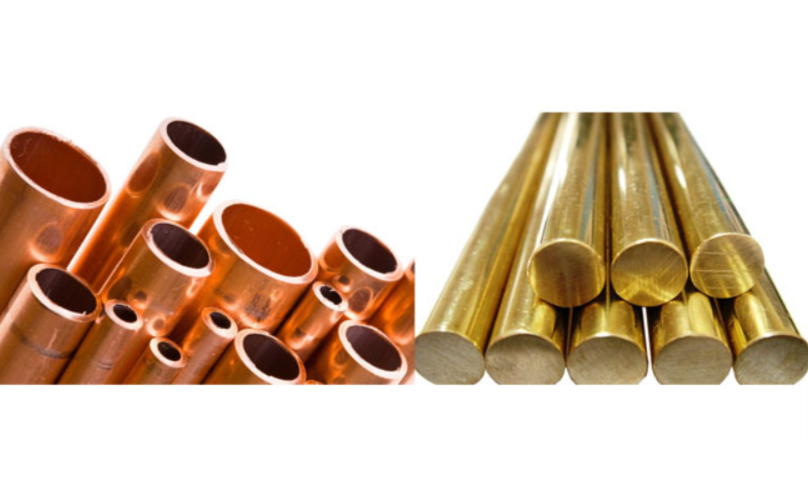What is the Difference between Copper and Brass?

Commencing a project with a focus on metal applications underscores the critical importance of selecting the right material to ensure the project’s success. Copper and Brass, both integral components of various industries, possess distinct properties that cater to different applications. Let’s delve into the nuances of copper and brass, shedding light on their characteristics, applications, and the factors that differentiate them.
Copper: The Time-Tested Metal
Copper, a naturally occurring metal, boasts high malleability, good thermal and electrical conductivity, and resistance to corrosion. Copper, renowned for its versatility, finds applications across a spectrum, from coins to industrial machinery, owing to its ability to maintain consistent electrical and mechanical properties even in cryogenic temperatures. Copper bars and Copper alloy ingots play a pivotal role in their product line.
Brass: The Alloy Advantage
In contrast, brass is a copper/zinc alloy, customizable with the addition of metals like iron, aluminum, silicon, or manganese to enhance specific characteristics. Brass, with its low melting point and high formability, is commonly used in decorative items, musical instruments, pipes, and electrical components. The inclusion of copper in brass maintains antimicrobial properties, making it valuable in applications requiring hygiene, such as architectural fittings.
Contact us today to gain insights or request a customized quote made according to your project needs.
Key Differences to Consider
Electrical Conductivity: A Crucial Distinction
One of the primary differences between copper and brass lies in their electrical conductivity. Copper, in its pure form, stands out as a highly conductive metal. Its electrons flow effortlessly, making it an ideal choice for applications where uninterrupted electrical flow is crucial. On the other hand, brass alloys introduce some level of electrical resistance, determined by the specific composition of the alloy. This variance makes copper the preferred material for applications that demand complete electrical conductivity, such as wiring and electrical components.
Corrosion Resistance: The Battle Against Oxidation
When it comes to resisting the effects of corrosion, brass takes the lead. Incorporating metals such as manganese into brass alloys not only boosts its corrosion resistance but also renders it a superb option for applications where susceptibility to moisture and other corrosive elements is a significant consideration. Copper, while naturally resistant to corrosion, may not match the level of protection offered by brass in certain applications. This distinction is critical, especially in industries where the longevity and durability of materials are paramount.
Melting Point: Temperature Tolerance Matters
Another key factor to consider is the melting point of copper products versus brass products. Copper boasts a higher melting point, reaching 1084°C compared to brass, which typically melts at temperatures ranging from 900°C to 940°C. This difference is significant in applications exposed to elevated temperatures. The choice between copper and brass, in this context, hinges on the specific temperature requirements of the project. Copper’s higher melting point makes it suitable for applications where resilience to heat is paramount.
Hardness: Balancing Strength and Formability
Brass components, owing to their alloy composition, are inherently harder than copper. The hardness of brass increases with higher zinc content, providing a balance between strength and formability. This characteristic makes brass a preferred material in scenarios where resistance to wear and tear is crucial. In contrast, copper’s softer nature makes it more malleable, and suitable for applications where flexibility and ease of shaping are priorities.
Machinability and Strength: Precision and Durability
Brass stands out with superior machinability, weldability, yield strength, and shear strength when compared to copper. These attributes make brass a go-to choice in industries that prioritize precision machining and durability. The enhanced machinability of brass simplifies the manufacturing process, contributing to its popularity in various industrial and consumer goods applications. Copper, while exhibiting commendable strength, may not match the machining capabilities of brass in certain contexts.
Cost: Navigating Budget Considerations
Cost is a crucial consideration in material selection, with copper generally carrying a higher price tag than brass, a difference influenced by factors like the specific alloy used and the quality of the material. While copper’s unique properties justify its higher cost in certain applications, brass provides a cost-effective alternative without compromising performance in many scenarios. Budget considerations, therefore, play a pivotal role in the decision-making process between copper and brass.
Understanding these key differences empowers decision-makers to choose the most suitable material for their projects, ensuring optimal performance and longevity. Whether the project demands the unparalleled conductivity of copper or the enhanced properties of brass, a thoughtful evaluation of these distinctions is crucial in achieving project success.
Your choice holds significance
The choice between brass and copper hinges on the specific environmental conditions and unique stresses that your final product is expected to encounter. Each metal offers distinct advantages tailored to specific applications.
At Sneh Metals, we acknowledge the significance of selecting the ideal material for your project. Setting ourselves apart with a steadfast commitment to delivering premium copper bars, copper alloy ingots, and an array of brass products, we prioritize customer satisfaction.

